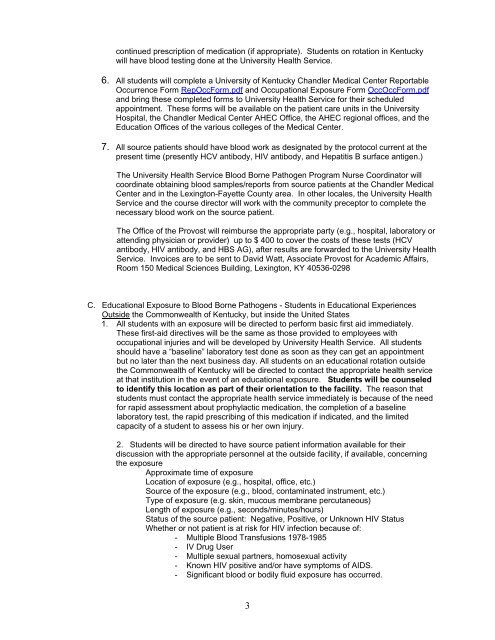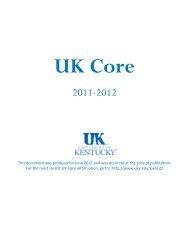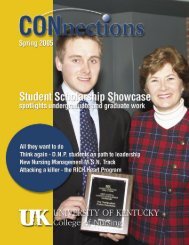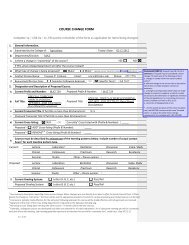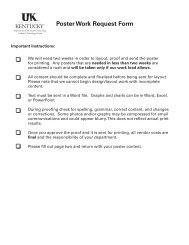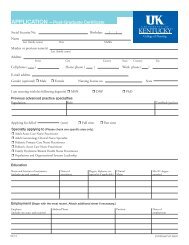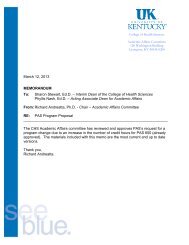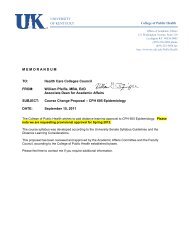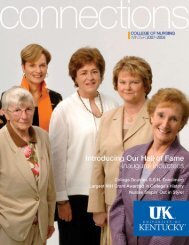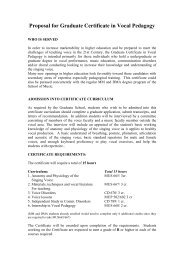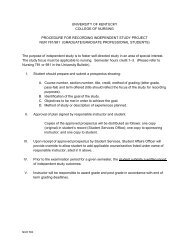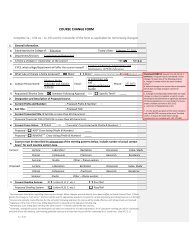05-06 Graduate Student Handbook.pdf - University of Kentucky
05-06 Graduate Student Handbook.pdf - University of Kentucky
05-06 Graduate Student Handbook.pdf - University of Kentucky
Create successful ePaper yourself
Turn your PDF publications into a flip-book with our unique Google optimized e-Paper software.
continued prescription <strong>of</strong> medication (if appropriate). <strong>Student</strong>s on rotation in <strong>Kentucky</strong><br />
will have blood testing done at the <strong>University</strong> Health Service.<br />
6. All students will complete a <strong>University</strong> <strong>of</strong> <strong>Kentucky</strong> Chandler Medical Center Reportable<br />
Occurrence Form RepOccForm.<strong>pdf</strong> and Occupational Exposure Form OccOccForm.<strong>pdf</strong><br />
and bring these completed forms to <strong>University</strong> Health Service for their scheduled<br />
appointment. These forms will be available on the patient care units in the <strong>University</strong><br />
Hospital, the Chandler Medical Center AHEC Office, the AHEC regional <strong>of</strong>fices, and the<br />
Education Offices <strong>of</strong> the various colleges <strong>of</strong> the Medical Center.<br />
7. All source patients should have blood work as designated by the protocol current at the<br />
present time (presently HCV antibody, HIV antibody, and Hepatitis B surface antigen.)<br />
The <strong>University</strong> Health Service Blood Borne Pathogen Program Nurse Coordinator will<br />
coordinate obtaining blood samples/reports from source patients at the Chandler Medical<br />
Center and in the Lexington-Fayette County area. In other locales, the <strong>University</strong> Health<br />
Service and the course director will work with the community preceptor to complete the<br />
necessary blood work on the source patient.<br />
The Office <strong>of</strong> the Provost will reimburse the appropriate party (e.g., hospital, laboratory or<br />
attending physician or provider) up to $ 400 to cover the costs <strong>of</strong> these tests (HCV<br />
antibody, HIV antibody, and HBS AG), after results are forwarded to the <strong>University</strong> Health<br />
Service. Invoices are to be sent to David Watt, Associate Provost for Academic Affairs,<br />
Room 150 Medical Sciences Building, Lexington, KY 4<strong>05</strong>36-0298<br />
C. Educational Exposure to Blood Borne Pathogens - <strong>Student</strong>s in Educational Experiences<br />
Outside the Commonwealth <strong>of</strong> <strong>Kentucky</strong>, but inside the United States<br />
1. All students with an exposure will be directed to perform basic first aid immediately.<br />
These first-aid directives will be the same as those provided to employees with<br />
occupational injuries and will be developed by <strong>University</strong> Health Service. All students<br />
should have a “baseline” laboratory test done as soon as they can get an appointment<br />
but no later than the next business day. All students on an educational rotation outside<br />
the Commonwealth <strong>of</strong> <strong>Kentucky</strong> will be directed to contact the appropriate health service<br />
at that institution in the event <strong>of</strong> an educational exposure. <strong>Student</strong>s will be counseled<br />
to identify this location as part <strong>of</strong> their orientation to the facility. The reason that<br />
students must contact the appropriate health service immediately is because <strong>of</strong> the need<br />
for rapid assessment about prophylactic medication, the completion <strong>of</strong> a baseline<br />
laboratory test, the rapid prescribing <strong>of</strong> this medication if indicated, and the limited<br />
capacity <strong>of</strong> a student to assess his or her own injury.<br />
2. <strong>Student</strong>s will be directed to have source patient information available for their<br />
discussion with the appropriate personnel at the outside facility, if available, concerning<br />
the exposure<br />
Approximate time <strong>of</strong> exposure<br />
Location <strong>of</strong> exposure (e.g., hospital, <strong>of</strong>fice, etc.)<br />
Source <strong>of</strong> the exposure (e.g., blood, contaminated instrument, etc.)<br />
Type <strong>of</strong> exposure (e.g. skin, mucous membrane percutaneous)<br />
Length <strong>of</strong> exposure (e.g., seconds/minutes/hours)<br />
Status <strong>of</strong> the source patient: Negative, Positive, or Unknown HIV Status<br />
Whether or not patient is at risk for HIV infection because <strong>of</strong>:<br />
- Multiple Blood Transfusions 1978-1985<br />
- IV Drug User<br />
- Multiple sexual partners, homosexual activity<br />
- Known HIV positive and/or have symptoms <strong>of</strong> AIDS.<br />
- Significant blood or bodily fluid exposure has occurred.<br />
3


